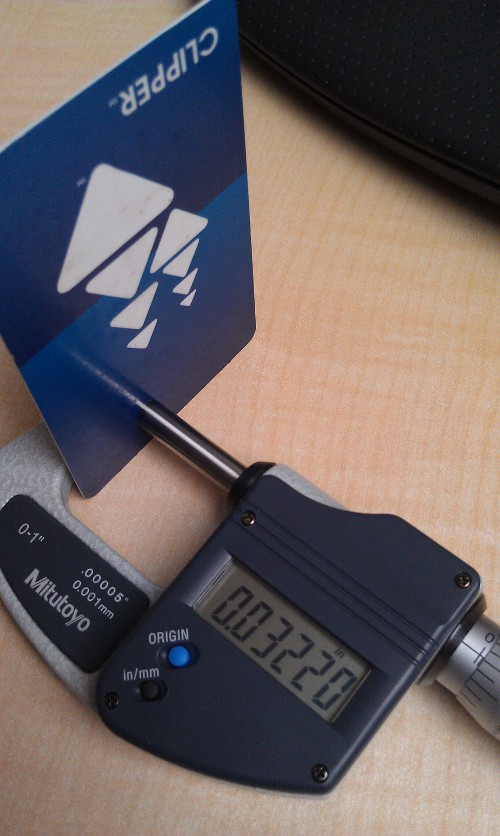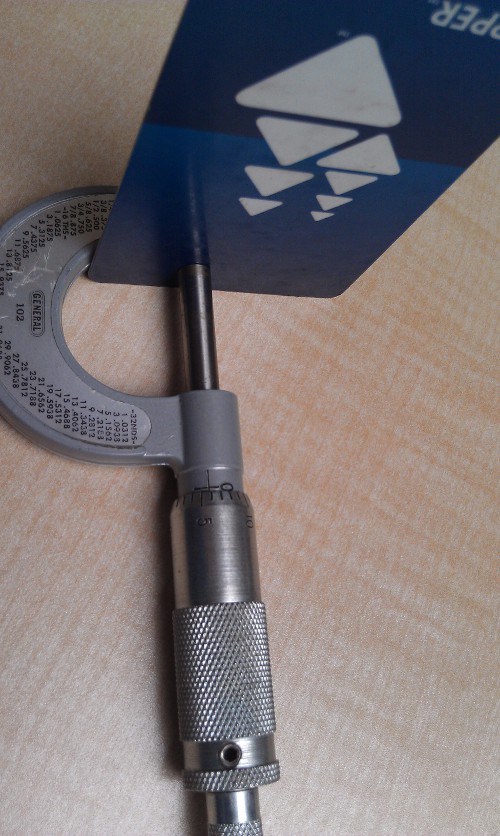Many of DeepRoot’s products are defined by their mil thickness. Our Geomembranes (Water Barrier and Bamboo Barrier), for example, have varying thicknesses of 30, 40 and 60 mil, while our root barriers are all 80 mil thick. But what is a mil?
A mil is a thousandth of an inch — .001 inch. It is a typical manufacturing dimension. When we make a product we specify the thickness as a mil.
How do you visualize such a small dimension? In order to help people understand what the mil thickness of a product is, I try to give them a point of reference. For example, I always explain that the 30 mil (30 divided by 1,000 = .030) Geomembrane is about the thickness of a credit card.

(By the way, Wikipedia uses the same comparison! Well, actually it uses plastic ID cards, but it’s the same idea. I’ve been saying this for years without Wikipedia’s help – actually I stole, er, borrowed the line from DeepRoot owner Julian Ray. For those who are interested and maybe a bit geeky like me you may want to read more about mils on the Wikipedia page.)
In the pictures in this post, I’m measuring the thickness of my Clipper Card (for the San Francisco transit system, MUNI) with both an old school and a digital micrometer to demonstrate this comparison (did I mention I am a bit of a geek?). It is easy to tell with the digital one that the Clipper card is .03 thick. The measurement is a little bit trickier with the old school one – math is involved, plus it is hard to show the small marks of the micrometer in a photo. Even though I love my, er, DeepRoot’s new digital micrometer, I always back up my finding with Mr. Old School trusty non digital micrometer.
Okay, so by now in this post you are aware that the micrometer is used to measure thicknesses. Wikipedia says that micrometers “are used widely for precise measurement of small distances…. Micrometers use the principle of a screw to amplify small distances that are too small to measure directly into large rotations of the screw that are big enough to read from a scale.” That’s a little heavy for me. I basically know it as the sweet tool that I use to check quality on the items we manufacture.
So there you have it – a brief explanation of what a mil is and why DeepRoot uses the term to describe so many of its products. But, honestly, I just wanted to show off the sweet micrometers.






Good article and well explained, as you say Wiki can be a little “heavy”.
what is full name of MIL?
Mil is not short for anything – it is its own unit of measurement and stands for one-thousandth of an inch.
How does one measure the thickness of a membrane while applying it? This is a membrane which is applied with a squeegee.
After it is applied can it be accurately measured and if so how?
thanks, Brian
Why rename a thou (thousandth of an inch) a mil?
A mil could easily be interpreted as the SI unit, millimetre, or as a micron (a thousandth of a millimetre). In the UK, Europe and most of the world, commercial membrane thickness is stated in millimetres for all practical purposes.
I feel sure some young people could be confused by this nonsense.
Roland, THAT is why ‘Merica is ‘exceptional’. We left the old world sometime ago and ain’t looked back since. And TRUST me there ain’t no fear that anyone on this side of the pond is gonna confuse a thou with anything called “SI Units”.
Could mil be from the French, “mille” for thousand? Isn’t that where cent weight came from? Cent for a hundred from the French, “cente”?
I hate to ask but is 30 mil thinner than 60 mil? I am wanting to purchase some magnetic sheets and I want the thicker sheets. It seems in some calculation the higher the number the smaller the material. I have to ask before I buy.
come on …. “mil” did not just pop up one day. mil is short for mili-inch. and it became popularized as a mil. it is easy to see that the term is related to the way mil is used in the if you were to look at the metric system, you will see that mili-meter is 1/1000th of a meter, mili-liter is 1/1000th of a liter and so on.
Er – you will see that [a] millimetre is 1/1000th of a metre, [a] millilitre is 1/1000th of a litre and so on. A metre is a unit of length; a meter is a measuring device.
We in the U.S. seem stuck with “standard” measures, using inches. It’s slight improvement to divide inches by tenths, hundredths, and thousandths, instead of going with 1/2 inch, 1/4 inch, 1/8 inch, 1/16 inch, etc. But clearly it would be better to switch entirely to the metric system, where everything is in units of 10.
Your mic’s aren’t reading the same. About 1.5 “mils” off.
Our imperial system of measurement has its benefits. Especially for those in construction. Base 10 is only divisible by 1,2,5,10. Base 12 (imperial or standard) is divisible by 1,2,3,4,6,12. 8 is also a handy # in this system as it divides cleanly at 24, 48, etc. We do have reasons for keeping our standard of measurement.